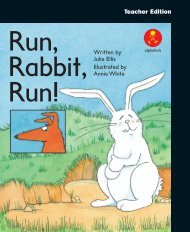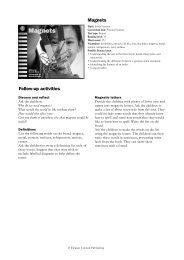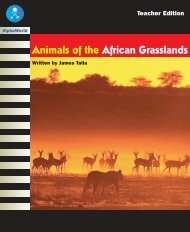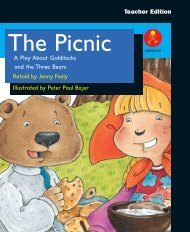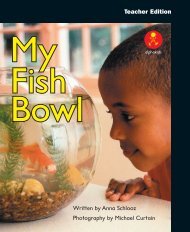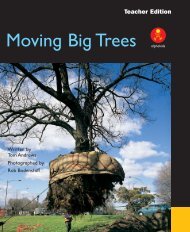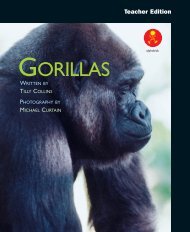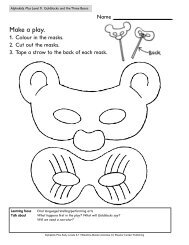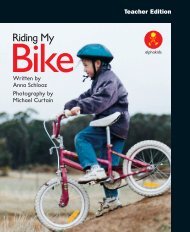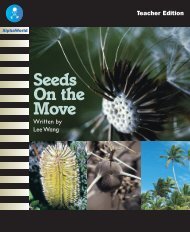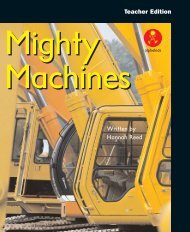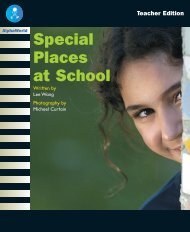Your Amazing Body
Your Amazing Body
Your Amazing Body
You also want an ePaper? Increase the reach of your titles
YUMPU automatically turns print PDFs into web optimized ePapers that Google loves.
Teacher Edition<br />
<strong>Your</strong><br />
<strong>Amazing</strong><br />
<strong>Body</strong><br />
alphakids<br />
Written by Sarah O’Neil<br />
Illustrated by Alex Stitt
Published edition<br />
© Eleanor Curtain<br />
Publishing 2004<br />
First published 2004<br />
Apart from any fair dealing for<br />
the purposes of study, research,<br />
criticism or review, as<br />
permitted under the Copyright<br />
Act of Australia, no part of this<br />
book may be reproduced by<br />
any process, or transmitted in<br />
any form, without permission<br />
of the copyright owner. Where<br />
copies of part or the whole of<br />
this book are made under Part<br />
VB of the Copyright Act, the<br />
law requires that records of<br />
such copying be kept and the<br />
copyright owner is entitled to<br />
claim payment.<br />
Developed by<br />
Eleanor Curtain Publishing<br />
Text: Nicole Di Marco<br />
Consultant: Susan Hill<br />
Designed by<br />
Alexander Stitt<br />
Production by<br />
Publishing Solutions<br />
Printed in China<br />
ISBN 0 7253 3416 9<br />
1 2 3 4 5 6 7 8 9<br />
04 05 06<br />
<br />
How to use this book<br />
Before reading: Talkthrough<br />
Talk through the book with the children. Encourage<br />
them to predict the text from the cover and the<br />
pictures, and to think about the information they<br />
provide. Direct the children’s attention to aspects of<br />
the text that may challenge them. Support the children<br />
to deal with these challenges by asking the<br />
Talkthrough questions on each page.<br />
During reading: Observe and support<br />
Observe the children as they read. Encourage them to<br />
monitor their own reading as they comprehend the<br />
text. As needed, support the children by helping them<br />
to discover and use reading strategies and cues to solve<br />
problems and respond to reading challenges that arise<br />
in the text. Interruptions to the children’s reading<br />
should be minimal and focused on specified learning<br />
needs.<br />
After reading: Comprehension, returning to<br />
the text, responding and writing links<br />
To further develop children’s understanding of the<br />
text, select from activities found on page 16 and the<br />
inside back cover. These whole text, sentence and word<br />
level activities reinforce the teaching focus of this<br />
book. Assessment ideas are provided to assist with<br />
planning for further teaching.<br />
Text highlights<br />
• A contents page is provided.<br />
• Diagrams, labels and pointers are used.<br />
• <strong>Amazing</strong> facts are featured in fact boxes.<br />
• Humorous illustrations support and<br />
extend the text.<br />
Vocabulary<br />
adult, amazing, bone, centimetres, connected,<br />
hair, human, kilograms, metres, muscles, nails,<br />
protect, sheds, skeleton, skin, teeth
Setting the context<br />
Discuss different parts of the body with the<br />
children.<br />
What is a skeleton What does it do Where<br />
is it What are muscles What do they do<br />
What does your skin do<br />
Introducing the book<br />
This book is about different parts of your<br />
body. It includes some amazing facts.<br />
Front cover<br />
Look at the front cover. What is unusual<br />
about the picture Why would a person be<br />
drawn like this What parts of the body<br />
might this book investigate<br />
Title page<br />
Read the title together.<br />
What does ‘amazing’ mean<br />
Point out the names of the author and<br />
illustrator.
<strong>Your</strong> <strong>Amazing</strong> <strong>Body</strong> Pages 2–3<br />
<br />
Talkthrough<br />
This is the contents page. The contents page lists the chapters<br />
in the book and the page on which each chapter begins.<br />
Do we need to read the book from cover to cover or can we just<br />
read the sections we want to<br />
Observe and support<br />
Can the children use information in the illustrations<br />
and text to understand new vocabulary<br />
What is a skeleton What helped you to work that out<br />
2
<strong>Your</strong> <strong>Amazing</strong> <strong>Body</strong> Pages 4–5<br />
<br />
Talkthrough<br />
Where is your skeleton What is it made up of<br />
Have a look at the ‘That’s amazing!’ fact box. What interesting<br />
facts about the skeleton does it tell you<br />
Observe and support<br />
Can the children locate what the book tells them<br />
What is the biggest bone in your body How do you know<br />
What is the smallest bone Show me where it tells you this.<br />
4
<strong>Your</strong> <strong>Amazing</strong> <strong>Body</strong> Pages 6–7<br />
<br />
Talkthrough<br />
What is this section called<br />
Can you flex your arm and show me your muscles <strong>Your</strong><br />
muscles help you to move and lift things.<br />
What amazing facts about muscles are contained in the fact box<br />
Observe and support<br />
Can the children use their knowledge of letter-sound<br />
relationships to support their reading<br />
If a child cannot read a word, ask the following<br />
questions:<br />
What letter does that word start with What sound might it make<br />
What sound does it end with<br />
What would make sense here<br />
6
<strong>Your</strong> <strong>Amazing</strong> <strong>Body</strong> Pages 8–9<br />
<br />
Talkthrough<br />
Show me where your skin is on your body.<br />
What do you think skin keeps out of your body<br />
What does it mean to ‘shed’ your skin Is two kilograms a<br />
lotofskin<br />
Did you know that dust could be made up of skin That is<br />
amazing!<br />
Observe and support<br />
Do the children read the text fluently<br />
I liked the way you read that. It sounded like talking and was<br />
easy for me to understand.<br />
8
<strong>Your</strong> <strong>Amazing</strong> <strong>Body</strong> Pages 10–11<br />
<br />
Talkthrough<br />
Does the hair on your head grow all the time How much does<br />
it grow each year<br />
What amazing fact is in the fact box<br />
Is eight metres very long Let’s get the metre ruler and check.<br />
Observe and support<br />
Can the children understand the inferences in the text<br />
Would having hair eight metres long be a good or bad thing<br />
Why<br />
10
<strong>Your</strong> <strong>Amazing</strong> <strong>Body</strong> Pages 12–13<br />
<br />
Talkthrough<br />
What do you use teeth for<br />
Why do adults have more teeth than children<br />
Have you still got your baby teeth What did it feel like when<br />
they fell out<br />
Observe and support<br />
Do the children use a range of cues – visual, structural<br />
and contextual – when they experience difficulty Are<br />
they relying heavily on just one source of information<br />
At the point of difficulty, ask questions that prompt<br />
them to use the cues they are overlooking.<br />
Try that again. What would sound right (or look right or make<br />
sense)<br />
12
<strong>Your</strong> <strong>Amazing</strong> <strong>Body</strong> Pages 14–15<br />
<br />
Talkthrough<br />
Nails grow on the ends of your hands and feet. What do<br />
they protect<br />
What amazing facts do you now know about nails<br />
Observe and support<br />
Can the children infer meaning from the text<br />
Why do the nails on your right hand grow faster if you are<br />
right-handed<br />
14
<strong>Your</strong> <strong>Amazing</strong> <strong>Body</strong> Page 16<br />
Talkthrough<br />
What does ‘human’ mean What do the labels show us Why<br />
has the author written ‘You have an amazing body’<br />
16<br />
After reading<br />
Being a meaning maker<br />
Encourage the children to support their responses<br />
with evidence from the book as they discuss these<br />
comprehension questions:<br />
How many teeth do you have Do all people have this many<br />
teeth<br />
How much does your hair grow each year<br />
Could everyone grow his or her hair as long as the man in<br />
India Why or why not<br />
Why is the largest muscle in your leg and the smallest in your<br />
head
Being a code breaker<br />
Explore the following language features:<br />
• High-frequency words: a, about, all,<br />
and, are, every, have, I, in, is, it,<br />
made, most, of, on, out, than, the,<br />
these, they, to, up, when, with, you,<br />
your<br />
• Hearing sounds: the children could<br />
be asked to listen for words in the<br />
book that end with the /s/ sound:<br />
bones, centimetres, ends, fingers,<br />
fingernails, grows, hands, kilograms,<br />
metres, muscles, nails, sheds, things,<br />
times, toenails, toes, weeks.<br />
• Other conventions: diagrams, labels,<br />
pointers, fact boxes.<br />
Being a text user<br />
Refer to the text when discussing these<br />
questions:<br />
What kind of book is this How do you know<br />
What kind of information is provided in the<br />
fact boxes How is this different from the<br />
other information<br />
What information is included in the<br />
illustrations<br />
Responding to text<br />
The children could work in<br />
cooperative groups to create a roleplay<br />
about the human body. Each child<br />
could be a part of the body and tell the<br />
audience about what this part does and<br />
an amazing fact about it.<br />
The children could make models<br />
of some of the amazing facts in the<br />
book. They could be displayed with ‘Did<br />
you know’ statements.<br />
The children could make a body<br />
dictionary, creating definitions of<br />
the different parts of the body and putting<br />
the entries into alphabetical order.<br />
Writing<br />
The children could use the information<br />
in the book to make a poster about the<br />
human body. Encourage them to use<br />
labels and pointers.<br />
Being a text critic<br />
What did the author need to know to write this<br />
book<br />
What has she included What has she left out<br />
Assessment<br />
Can the children:<br />
• point out a label and explain what its purpose is<br />
• understand the inferences in the text; for example, ‘How many teeth will you<br />
have when you are an adult’<br />
whole text activity sentence activity word activity
ALPHAKIDS<br />
Teacher<br />
Edition<br />
Other<br />
books<br />
at this<br />
level<br />
alphakids<br />
Circus Boy<br />
Written by Mary-Anne Creasy<br />
Photography by Michael Curtain<br />
Topic: Human body<br />
Curriculum Link: Science/ Health and Physical<br />
Education<br />
Text type: Explanation<br />
Reading level: 11<br />
Word count: 117<br />
High-frequency words: a, about, all, and, are,<br />
every, have, I, in, is, it, made, most, of, on, out, than,<br />
the, these, they, to, up, when, with, you, your<br />
Vocabulary: adult, amazing, bone, centimetres,<br />
connected, hair, human, kilograms, metres, muscles,<br />
nails, protect, sheds, skeleton, skin, teeth<br />
BillyBanana<br />
Written by<br />
Jack Hastings<br />
Illustrated by<br />
Chantal Stewart<br />
Flying<br />
Machines<br />
Written by Mary-Anne Creasy<br />
alphakids<br />
alphakids<br />
The Baby Picnic Bear<br />
A Play About Goldilocks<br />
and the Three Bears<br />
Goes for a Walk<br />
Retold by Jenny Feely<br />
Illustrated by Peter Paul Bajer<br />
GORILLAS<br />
WRITTEN BY<br />
TILLY COLLINS<br />
alphakids<br />
PHOTOGRAPHY BY<br />
MICHAEL CURTAIN<br />
Possible literacy focus<br />
Understanding the features and purpose of diagrams<br />
and labels.<br />
Drawing inferences from the information presented<br />
in the text.<br />
Summary<br />
This book provides information about different<br />
parts of the human body.<br />
ISBN 0- 7253- 3416- 9<br />
9 780725 334161<br />
alphakids



